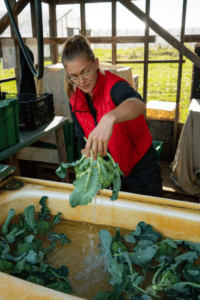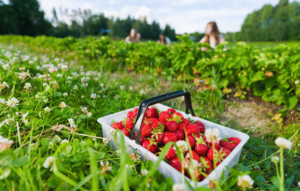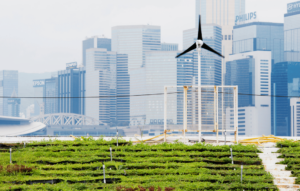Imagine your dinner’s journey from farm to plate. Each ingredient has traveled hundreds, if not thousands, of miles, leaving a significant trail of pollution and greenhouse gas emissions in its wake. This invisible footprint of our food, known as “food miles,” highlights a critical but often overlooked environmental issue. 
While reducing meat consumption is frequently promoted as a solution to combat environmental degradation, this approach can be shortsighted. The true solution lies in embracing local and seasonal eating, which addresses the root of the problem by minimizing the distance our food travels. By focusing on local and seasonal consumption, we can effectively reduce the environmental impact of our diets, supporting sustainable food systems and promoting overall health.
This blog will explore the concept of “food miles” and their environmental impact, the benefits of eating local and seasonal foods, and why the common recommendation to simply reduce meat consumption misses the mark. Let’s look into why local and seasonal eating is not just a trend but a vital practice for a sustainable future.
Understanding “Food Miles”
“Food miles” refer to the distance food travels from where it is grown or produced to where it is ultimately consumed. This concept highlights the journey food takes through various stages, including production, processing, packaging, and distribution. Each stage adds to the total distance covered, and consequently, to the overall environmental footprint of the food we eat.
The Environmental Impact
The transportation of food significantly contributes to greenhouse gas emissions. Trucks, planes, and ships used to move food around the globe all rely on fossil fuels, which release carbon dioxide and other pollutants into the atmosphere. For instance, transporting out-of-season fruits from one hemisphere to another involves extensive energy use and emissions. This transportation not only affects air quality but also contributes to climate change, as the accumulated emissions from food transportation form a notable part of our carbon footprint.

Moreover, the pollution generated by food transportation extends beyond greenhouse gases. Vehicles involved in long-distance food transport emit particulate matter and other pollutants, which can have adverse health effects on communities located near major transportation routes. By understanding the concept of “food miles” and their environmental impact, we can better appreciate the importance of reducing these distances through local and seasonal eating practices.
The Case for Eating Local
Environmental Benefits
One of the most compelling reasons to eat locally is the significant reduction in the carbon footprint associated with food transportation. When food is sourced from nearby farms, the distance it travels from farm to table is dramatically shortened, resulting in fewer emissions from vehicles. This reduction in “food miles” translates directly to lower greenhouse gas emissions and less pollution, making local eating a powerful tool in combating climate change.
Another environmental benefit of eating locally is the decreased energy consumption required for storage and preservation. Locally grown produce is often fresher and doesn’t need extensive refrigeration or preservation methods, which are typically energy-intensive. By consuming food closer to its source, we minimize the need for these processes and contribute to a more sustainable food system.
Economic and Community Benefits
Eating local supports local farmers and strengthens regional economies. When consumers buy from local farmers’ markets or participate in community-supported agriculture (CSA) programs, they are directly contributing to the livelihoods of local producers. This financial support helps sustain small farms and encourages the growth of local food networks, which can be more resilient and adaptable than large-scale industrial food systems.
Strengthening community ties is another significant benefit of eating local. Local food systems foster connections between consumers and producers, creating a sense  of community and mutual support. These relationships can lead to greater community engagement and investment in local food initiatives, further promoting sustainability and global food security.
of community and mutual support. These relationships can lead to greater community engagement and investment in local food initiatives, further promoting sustainability and global food security.
Health Benefits
Local produce is often fresher and more nutritious than food that has traveled long distances. Fruits and vegetables that are allowed to ripen fully before harvest retain more nutrients and offer better taste and quality. Additionally, local food is less likely to require preservatives or chemicals to extend its shelf life, resulting in fewer additives and potentially harmful substances in your diet.
By choosing to eat local, consumers can enjoy a healthier, more flavorful diet while simultaneously supporting environmental sustainability and community well-being. This holistic approach to food consumption addresses multiple facets of health and sustainability, making it a compelling alternative to the often oversimplified recommendation to “just eat less meat”, which is one of, if not the most nutrient-dense sources of food on the planet.
Seasonal Eating Helps Too
What is Seasonal Eating?
Seasonal eating involves consuming foods that are grown and harvested during their natural growing seasons. For example, enjoying strawberries in the summer when they are naturally abundant, or savoring root vegetables like carrots and potatoes in the winter. This practice aligns our diets with the natural rhythms of the agricultural calendar, ensuring that our foods are at their peak.

Benefits of Seasonal Eating
One of the key benefits of seasonal eating is the reduced need for energy-intensive storage and transportation. When we eat foods that are in season, they do not require long-term refrigeration or long-distance shipping, both of which consume significant amounts of energy and contribute to greenhouse gas emissions. By eating seasonally, we can enjoy fresher, tastier produce that has a smaller environmental footprint.
Seasonal eating also leads to higher-quality produce. Foods that are grown and harvested in their natural seasons are typically more flavorful and nutritious. They are allowed to ripen fully in the field, rather than being picked early and artificially ripened during transport. This results in better taste and a higher concentration of vitamins and minerals.
Combining Local and Seasonal Eating
The combination of local and seasonal eating maximizes the environmental and health benefits of our food choices. By focusing on foods that are both locally sourced and in season, we can significantly reduce the carbon footprint of our diets. This approach minimizes the energy and emissions associated with food transportation and storage, while also supporting local farmers and enjoying fresher, more nutritious foods.
Moreover, local and seasonal eating fosters a deeper connection with the food we consume and the environment in which we live. It encourages us to be more mindful of the natural cycles of growth and harvest, promoting a sustainable and holistic approach to our diets. This practice not only benefits our health and the environment but also supports the resilience and sustainability of local food systems.
Practical Steps to Eat Local and Seasonal
Making the switch to a local and seasonal diet can be simple and rewarding. Here are some practical tips to help you get started: 
- Shop at Farmers’ Markets: Farmers’ markets are excellent places to find fresh, local produce. They provide an opportunity to meet and support local farmers directly. Shopping at these markets ensures that you are buying food that is in season and has traveled a minimal distance.
- Join a CSA (Community Supported Agriculture) Program: CSA programs allow you to subscribe to a share of a farm’s harvest. Each week, you receive a box of fresh, seasonal produce. This not only supports local agriculture but also introduces you to a variety of seasonal foods.
- Use Seasonal Produce Guides: Many resources are available that provide information on what foods are in season in your area. These guides can help you plan your meals around the freshest, most sustainable options available. Season Food Guide is a good one.
- Grow Your Own Food: If you have the space, consider starting a garden. Growing your own vegetables and herbs ensures a fresh, local supply and connects you more closely with the cycles of nature.
- Preserve Seasonal Produce: Learn methods of preserving food such as canning, freezing, and drying. This allows you to enjoy local, seasonal produce year-round and reduces the need for out-of-season imports.
Community and Policy Initiatives
Beyond individual actions, community and policy initiatives can play a crucial role in promoting local and seasonal eating:
- Support Local Food Systems: Advocate for policies that support local food producers, such as subsidies for small farms and incentives for local food markets. Encouraging local governments to invest in local food infrastructure can help create a more robust and sustainable food system.
- Promote Farm-to-School Programs: These programs connect schools with local farms to provide fresh, healthy meals to students. Farm-to-school initiatives not only improve the quality of school meals but also educate children about the benefits of local and seasonal eating.

- Develop Urban Agriculture: Support urban farming projects and community gardens. These initiatives can increase access to fresh produce in urban areas and reduce the distance food travels from farm to table.
- Encourage Local Food Education: Promote educational programs that teach community members about the benefits of local and seasonal eating. Workshops, cooking classes, and farm tours can help people understand where their food comes from and how to make sustainable choices.
By incorporating these practical steps and supporting community initiatives, we can make significant strides towards a more sustainable and healthful food system. Eating local and seasonal is not just a personal choice but a collective effort that seriously benefits our environment, health, and communities.
Closing Thoughts
The journey our food takes from farm to table has a profound impact on the environment, contributing significantly to pollution and greenhouse gas emissions. While reducing meat consumption is often touted as a solution, this approach overlooks the broader issue of “food miles” and the potential benefits of local and seasonal eating that we can all take meaningful steps toward.
By focusing on consuming food that is both locally sourced and in season, we can drastically reduce the carbon footprint of our diets. This approach not only minimizes the environmental costs associated with long-distance food transportation and energy-intensive storage but also supports local economies, fosters community connections, and provides fresher, more nutritious food.
Practical steps such as shopping at farmers’ markets, joining CSA programs, using seasonal produce guides, growing your own food, and preserving seasonal produce can make a significant difference. Additionally, community and policy initiatives that support local food systems, promote farm-to-school programs, develop urban agriculture, and encourage local food education are crucial for creating a sustainable food future.

By making these small yet impactful changes, we can collectively contribute to reducing pollution and greenhouse gas emissions. Embracing local and seasonal eating is a holistic and effective strategy for achieving environmental sustainability and improving our health and well-being. Let’s commit to making more informed and sustainable food choices for the sake of our planet and future generations.










